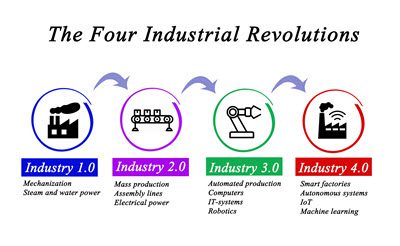The Industrial Revolution signifies a pivotal phase marked by substantial shifts in the production and exchange of goods, serving as a driving force for the modernization of our world. This transformative period, characterized by the exploration of new energy sources and technological advancements, has not only given rise to fresh industries but also brought about a metamorphosis in existing ones. Commencing with the discovery of coal in 1765 and progressing to the current Industry 4.0, the Industrial Revolution has orchestrated an extraordinary evolution, fundamentally reshaping our global landscape. Here is a brief summary of each of the four industrial revolutions:

1. First Industrial Revolution: Coal in 1765
The initiation of industrialization took place in the latter part of the 18th century during the First Industrial Revolution. Fueled by coal, this period witnessed the mechanization of conventional manual labor. Innovations such as the steam engine and advancements in metal forging played a crucial role in establishing the groundwork for a transition from agrarian economies to industrial ones. The introduction of canal transportation additionally streamlined the movement of goods, signifying a notable departure from traditional methods.
2. Second Industrial Revolution: Gas in 1870
The Second Industrial Revolution, around 1870, was defined by the widespread use of electricity, gas, and oil. This era witnessed the emergence of the combustion engine, which revolutionized transportation. The introduction of steel- and chemically-based products transformed industries, while communication technologies, such as the telegraph and telephone, accelerated global connectivity. Mass production techniques became a hallmark of this era, enhancing mechanical production speed.
3. Third Industrial Revolution: Electronics and Nuclear in 1969
The third quarter of the 20th century marked the onset of the Third Industrial Revolution, marked by progress in electronics and the harnessing of nuclear energy. Initially gaining traction in Europe, nuclear power extended its influence to the United States and Great Britain and witnessed a resurgence in Asia. Electronics permeated various sectors, with computers and integrated circuits reshaping both industries and daily life.
4. Fourth Industrial Revolution: Internet and Renewable Energy in 2000
The current Fourth Industrial Revolution initiated approximately in the year 2000, stands out for its amalgamation of the internet, renewable energy sources, and advanced digital technologies. While renewable energy sources like solar, wind, and geothermal play a pivotal role, it is the rapid progression of digital technology that propels this era. The foundational elements of this revolution include the Industrial Internet of Things (IIoT), cloud technology, artificial intelligence, and Computerized Maintenance Management Systems (CMMS).
The Role of CMMS in the Fourth Industrial Revolution
CMMS, a crucial component in modern maintenance strategies, plays a pivotal role in the Fourth Industrial Revolution. This system facilitates the organization and optimization of maintenance activities. By leveraging CMMS, industries can streamline preventive maintenance, manage work orders efficiently, and harness real-time data for informed decision-making. The integration of CMMS with the Industrial Internet of Things (IIoT) enables predictive maintenance, minimizing downtime and enhancing overall operational efficiency. In the evolving landscape of the Fourth Industrial Revolution, CMMS emerges as a tool that not only ensures the reliability of machinery but also contributes to the intelligent and data-driven functioning of industrial processes.
Final Thoughts
The four industrial revolutions delineate the evolutionary journey of industrial societies, each leaving an indelible mark on how we produce, consume, and interact. In the current era of the Fourth Industrial Revolution, the convergence of digital technologies and sustainable energy sources is reshaping industries, with CMMS playing a crucial role in enhancing maintenance practices and overall operational efficiency.
FAQs About The 4 Industrial Revolutions
What is the purpose of preventive maintenance in industrial settings?
Preventive maintenance aims to proactively address potential equipment issues before they escalate, minimizing downtime, enhancing reliability, and optimizing overall operational efficiency.
How does a Computerized Maintenance Management System (CMMS) contribute to effective maintenance strategies?
CMMS streamlines maintenance tasks by organizing data, providing real-time access, and facilitating efficient documentation. It enhances troubleshooting, enables predictive maintenance, and fosters smarter decision-making in industrial settings.
Why is the integration of renewable energy sources significant in the Fourth Industrial Revolution?
In the Fourth Industrial Revolution, the integration of renewable energy sources like solar and wind ensures sustainable and eco-friendly operations. This shift contributes to reducing the environmental impact of industrial processes while aligning with global sustainability goals.
Other Resources
Checklists
Articles and Directories of Terms & Definitions
Customer Testimonials
Customer Case Studies